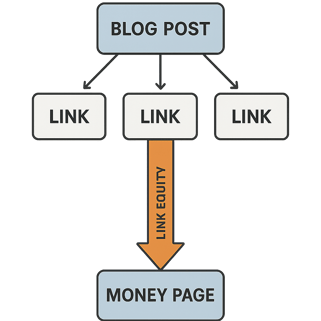Why Internal Linking Becomes Critical in Q4
While retailers often obsess over ad copy, product launches, and seasonal promotions during the holiday season, they frequently overlook one of the most critical drivers of SEO performance: internal linking.
This strategy becomes paramount in Q4, when your site experiences both the highest traffic and the highest competition. By optimizing your internal links, you ensure that visitors and search engines can easily find and prioritize your most valuable pages, often called “money pages,” which generate the bulk of your revenue.
For SEO leads, content strategists, and growth marketers, a sound internal link structure created before November can yield a compounding effect: stronger rankings, better navigation, and more conversions.
What Are “Money Pages”?
Money pages are the URLs most directly tied to conversions. In retail, these typically include:
-
High-margin product category pages (e.g., “holiday electronics deals”)
-
Seasonal landing pages (e.g., “Black Friday Laptop Sale 2025”)
-
Gift guide collections
-
Top-selling product detail pages
Without proper internal links, these pages may remain buried within your site hierarchy, starving them of both authority and traffic.
How a Strong Internal Link Structure Supercharges Your Money Pages
Passes Link Equity
Search engines view internal links as signals of importance. Linking from high-authority pages like your homepage or top-performing blogs gives money pages the authority to rank faster.

Improves Crawl Efficiency
With thousands of SKUs and faceted navigation, e-commerce sites can waste crawl budget (the number of pages Google is willing to crawl on a site). Strategic internal linking ensures Googlebot indexes the right pages during peak seasons.
Enhances User Journeys
Internal links guide users from informational content to purchase-ready pages. For example, a blog about “Best Gifts for Remote Workers” can link directly to a “Holiday Tech Accessories” category page. This strategy is a core component of effective CRO (Conversion Rate Optimization) to help move users down the funnel.
Internal Linking Strategies for Q4 Success
Audit Current Links
LEverage tools like Screaming Frog to run a crawl of your site or use Ahrefs' Site Explorer to quickly identify:
-
Money pages with fewer than five inbound internal links.
-
High-traffic content pages that aren’t linking to revenue pages.
-
Anchor text opportunities where vague links (“click here”) can be replaced with descriptive, keyword-rich text.
This data-driven approach, often managed with robust analytics solutions, is essential for a sound SEO strategy.
Build Seasonal Topic Clusters
Create supporting blog content hierarchy around holiday queries and funnel authority to money pages.
Elevate Holiday Pages in Navigation
Add gift guides or promotional pages directly into your top nav and footer during Q4. This gives them sitewide link authority and ensures shoppers can access them in one click.
Use Contextual Anchor Text
Anchor text should describe the target page. For example:
Repurpose Evergreen Pages for Seasonal Authority
Link from high-traffic evergreen blogs to seasonal pages. For example, a year-round “Best Laptops for Students” article can link to “Cyber Monday Laptop Deals 2025” during November.
Real-World Example: ACV Auctions
In preparing its platform for greater visibility, ACV Auctions restructured site content and strengthened internal linking to emphasize priority pages. The result was a 278% increase in page-one keyword rankings and a 92% lift in registrations year over year.
Retailers can apply the same principle to holiday money pages, ensuring internal authority flows directly to the URLs most likely to convert.

Ready to improve your site's visibility? Get a free SEO consultation.
Advanced Tip: Automate Link Opportunities
Use automated systems or internal link plugins to scale opportunities. But always balance automation with strategy. Links should enhance the user journey, not clutter pages with irrelevant CTAs.
Key Takeaways
-
Identify your money pages now and ensure they receive sufficient internal links.
-
Use topic clusters and supporting blogs to funnel authority toward high-value seasonal pages.
-
Elevate seasonal promotions into navigation and footer links during Q4.
-
Replace vague anchor text with descriptive, keyword-rich phrases.
-
Repurpose evergreen content to strengthen holiday-specific landing pages.
Marketers who prioritize internal linking will see their holiday campaigns not only attract more traffic but also convert more visitors into customers.
At (un)Common Logic, we help retailers design internal linking strategies that maximize visibility and revenue during peak demand. Learn more about our SEO services or or e-commerce solutions for retailers.
Internal Linking for Conversions: FAQs
How many internal links should a money page have?
There’s no universal number, but 10–20 links from relevant, authoritative pages is a good benchmark for high-priority Q4 pages.
Should I add holiday pages to the main navigation?
Yes. Doing so gives them sitewide authority and makes them easier for both users and search engines to find.
Can blog content really influence money page rankings?
Yes. Blogs attract long-tail traffic and topical authority, which can be funneled to revenue-driving pages with the right linking strategy.
Should internal links always use exact-match keywords?
Not always. Mix in variations to avoid spam signals and improve natural readability.